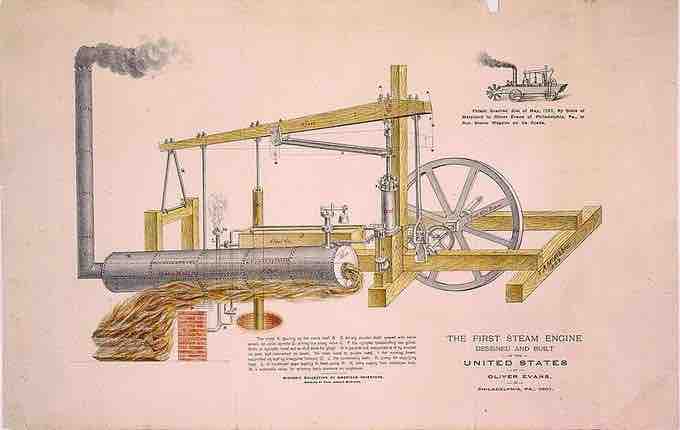Introduction: The Industrial Revolution
The Industrial Revolution was a global phenomenon marked by the transition to new manufacturing processes in the period from about 1760 to 1840. The Industrial Revolution began in the United Kingdom, and mechanized textile production spread from Great Britain to continental Europe and the United States in the early nineteenth century. During this Revolution, changes in agriculture, manufacturing, mining, transportation, and technology profoundly affected social and economic conditions in the United States.
New Innovations
Though the United States borrowed significantly from Europe's technological advancements during the Industrial Revolution, several great American inventions emerged at the turn of the nineteenth century that greatly affected manufacturing, communications, transportation, and commercial agriculture.
Advances in Technology
In the 1780s, Oliver Evans invented an automated flour mill that eventually displaced traditional gristmills. Evans's system for handling bulk material became widely used in flour mills and breweries during the nineteenth century and is among the innovations credited with the development of the assembly line. By the turn of the century, Evans also had developed one of the first high-pressure steam engines and began establishing a network of machine workshops to manufacture and repair these popular inventions. In 1793, Eli Whitney developed a machine to separate the seeds of short-fibered cotton from the fibers. The resulting cotton gin generated huge profits for slave-holding cotton planters in the South. In the early 1830s, Cyrus McCormick's horse-drawn mechanical reaper allowed farmers in the West to harvest great quantities of wheat, leading to great crop surpluses.
Reliance on horse power for machinery in the United States soon gave way to water power; this resulted in a concentration of industrialization developing in New England and the rest of the northeastern United States, where fast-moving rivers were located. The great number of rivers and streams along the Atlantic seaboard provided optimal sites for mills and the infrastructure required for early industrialization.
Between 1800 and 1820, additional industrial tools emerged that rapidly increased the quality and efficiency of manufacturing. In the first two decades of the 1800s, the development of all-metal machine tools and interchangeable parts facilitated the manufacture of new production machines for many industries. Steam power fueled by coal, wide utilization of water wheels, and powered machinery became common features of the manufacturing industry.
Improved Transportation
During this period, domestic trade also expanded with the introduction of canals, improved roads, and railways. In 1807, Robert Fulton built the first commercial steamboat, which operated between New York City and Albany. With the proliferation of new canal routes in the 1820s and 1830s, steamboat technology was crucial to domestic freight shipments in the United States.
Subsistence farming declined, and more consumer goods arrived on the market. The transition away from an agricultural-based economy toward machine-based manufacturing led to a great influx of population from the countryside, causing towns and cities to swell in population.
Communication
The communications revolution that began in this period served to connect communities and transform business. In 1836, Samuel F. B. Morse and Alfred Vail developed the American version of the electrical telegraph system, which allowed messages to be transmitted through wires over long distances via pulses of electric current. Messages were transcribed using the signaling alphabet known as "Morse code."
Effects of the Industrial Revolution
The Industrial Revolution marked a major turning point in history. During this period, the average income and population began to exhibit unprecedented, sustained growth. In the two centuries following the 1800s, the world's average per capita income increased more than tenfold, while the world's population increased more than sixfold.
The profound economic changes sweeping the United States led to equally important social and cultural transformations. The formation of distinct classes, especially in the rapidly industrializing North, was one of the most striking developments. The unequal distribution of newly created wealth spurred new divisions along class lines. Each class had its own specific culture and views on the issue of slavery. The elite lived and socialized apart from members of the growing middle class. The middle class valued work, consumption, and education and dedicated their energies to maintaining or advancing their social status. Wage workers formed their own society in industrial cities and mill villages, though lack of money and long working hours effectively prevented the working class from consuming the fruits of their labor, educating their children, or advancing up the economic ladder.

Steam engine design, 1801
This is the original steam engine design patented by Oliver Evans.